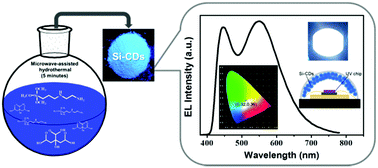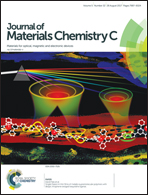Microwave-assisted hydrothermal synthesis of solid-state carbon dots with intensive emission for white light-emitting devices†
Abstract
A one-pot microwave-assisted hydrothermal approach was developed to quickly synthesize organosilane-functionalized carbon dots (Si-CDs) within 5 minutes. With the assistance of N-(β-aminoethyl)-γ-aminopropyl trimethoxysilane (KH-792) as distance barrier chains, aggregation-caused quenching is suppressed successfully, which contributes to the emission of bright blue fluorescence by solid-state Si-CDs (λem ∼ 454 nm). The photoluminescence quantum yield of the as-prepared Si-CDs in the solid state reaches 65.8% with an optimized molar ratio of the reactant citric acid to KH-792 of 1 : 5 and a reaction temperature of 180 °C, which is 2.5-fold that of their solution. Together with their good film-forming ability and thermal stability, Si-CDs were applied to fabricate a white-light-emitting device with color coordinates of (0.32, 0.36) and a correlated color temperature of 6071 K. Our results indicate that the as-prepared Si-CDs are promising materials with efficient solid-state emission to be used in lighting, backlight displays and other optoelectronic devices.



 Please wait while we load your content...
Please wait while we load your content...